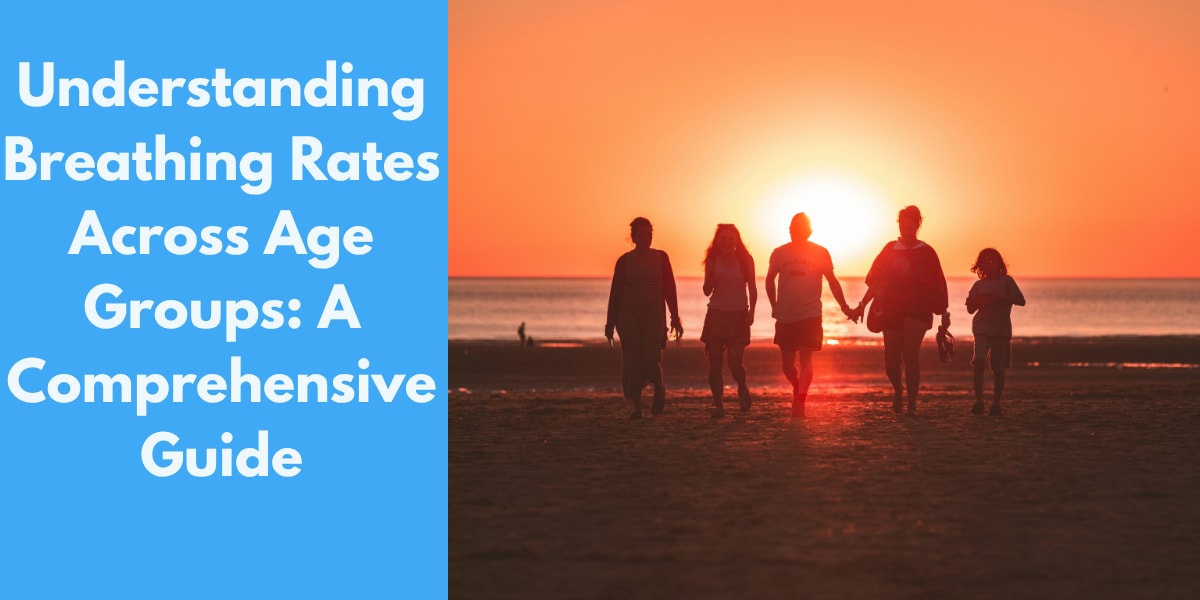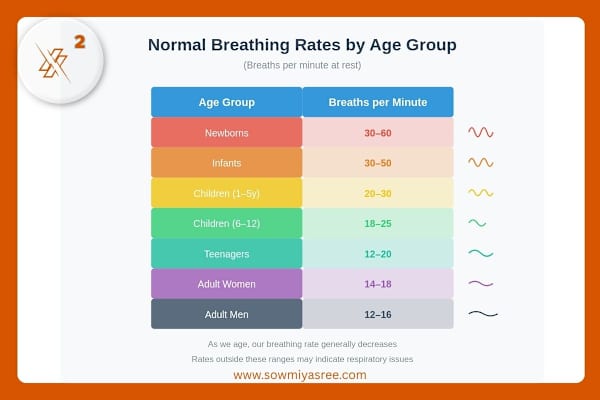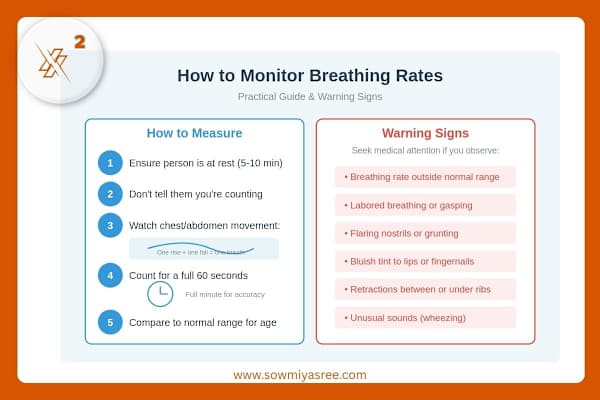⏳8 min. Estimated Reading time.
🙋♂️Introduction
Did you know that newborns breathe up to 60 times per minute — nearly four times faster than an adult man? This striking difference reveals just how much our respiratory patterns change throughout our lives. Understanding normal breathing rates isn’t just fascinating — it’s a crucial respiratory health monitoring skill that can provide peace of mind or alert you to potential breathing problems.
Breathing rates are often overlooked vital signs, yet they can tell us volumes about our overall respiratory health and physiological development. Whether you’re a new parent anxiously watching your baby’s chest rise and fall or someone interested in optimizing your own breathing patterns, knowing what’s normal can transform worry into confidence.
In this comprehensive guide to breathing rates, you’ll learn:
- The normal breathing rate ranges for every age group — from newborns to adults
- Why newborns breathe faster than adults and how rates change across the lifespan
- How to measure breathing rate at home accurately and easily
- When breathing variations might signal a need for medical attention
- Practical tools and techniques for respiratory health monitoring
💡 Quick Summary
- Newborns breathe 30-60 times per minute, while adults breathe only 12-18 times per minute
- Children’s breathing rates gradually slow down as their lungs develop and grow
- Women typically breathe slightly faster than men (14-18 vs 12-16 breaths per minute)
- How to monitor: Count for a full minute while the person is unaware and at rest
- Warning signs: Rates outside normal ranges, labored breathing, bluish lips, unusual sounds
- Essential tools: Smartphone apps, pulse oximeters, and specialized monitors are available
- Solution: Understanding normal patterns reduces anxiety and improves health monitoring
Let’s dive into the fascinating world of respiratory physiology and discover how each breath tells a story about our bodies.
📋Table of Contents
What are Normal Breathing Rates?
Age Group Normal Breathing Rate (breaths per minute)
Understanding Age-Related Breathing Patterns
Best Practices for Monitoring Breathing Rates
When to Worry About Breathing Rates
Essential Tools and Resources for Respiratory Monitoring
Breathing Exercises for Respiratory Health
Conclusion
Frequently Asked Questions
Scientific Research and Studies on Breathing Rates Across Age Groups
🍃What are Normal Breathing Rates?
Normal breathing rates — also called respiratory rates — refer to the number of breaths a person takes per minute when at rest. This vital sign varies significantly across age groups due to differences in metabolism, lung size, and oxygen requirements.
Here's a quick reference guide to normal breathing rates by age:
👶🏻Age Group Normal Breathing Rate (breaths per minute)
Understanding these respiratory rate ranges is important because breathing frequency is a key indicator of overall respiratory health. It's often called the "neglected vital sign" despite being just as important as pulse, blood pressure, and temperature in assessing well-being.
Research published in the Journal of Clinical Monitoring and Computing shows that abnormal respiratory rates are often the first indicator of clinical deterioration in many conditions — making this knowledge not just interesting but potentially life-saving.
Now that we understand what constitutes normal breathing rates, let's explore why these patterns matter and how to interpret them.
👪Understanding Age-Related Breathing Patterns
Newborns and Infants: Rapid Respirations
Newborns breathe significantly faster than any other age group, taking 30-60 breaths per minute. Why newborns breathe faster than adults is a fascinating aspect of respiratory development — their tiny lungs and high metabolic rate demand greater oxygen delivery.
Why it's important: This fast breathing compensates for several physiological factors unique to newborns:
- Smaller lung surface area for gas exchange
- Higher metabolic needs during rapid growth
- Less efficient respiratory muscles
- Narrower airways that require more effort to move air
Parents should know that newborn breathing often appears irregular, with short pauses and periodic variations in depth. This pattern, called "periodic breathing,” is normal in many infants and typically resolves by 6 months of age.
Children: The Gradual Slowdown
As children grow from toddlers to pre-teens, their breathing rate gradually decreases — from 20-30 breaths per minute in preschoolers to 18-25 breaths per minute in older children.
Why it’s important: This progressive slowing in pediatric respiratory rates reflects:
- Increasing lung capacity and efficiency
- Developing respiratory muscles
- The maturing nervous system controls
- Decreasing metabolic demand per unit of body weight
This transition period provides an excellent window for teaching children awareness of their own breathing patterns — setting the foundation for basic breathing exercises that can serve them throughout life.
Teenagers and Adults: Stabilizing Patterns
By adolescence, breathing rates approach adult norms of 12-20 breaths per minute, with slight gender differences emerging. Adult women typically maintain slightly higher respiratory rates (14-18 breaths per minute) than men (12-16 breaths per minute).
Why it’s important: These gender differences in adult breathing rates reflect:
- Variations in body composition and metabolic needs
- Hormonal influences on respiratory control
- Differences in average lung volumes
Understanding your personal baseline breathing rate can help you recognize when your respiratory health is in danger, particularly during illness or after injury.
🩺Best Practices for Monitoring Breathing Rates
How to Measure Breathing Rate at Home
Accurately monitoring respiratory rates is a simple yet valuable skill for respiratory health assessment. Here are expert-recommended approaches for breath counting and measurement:
- Count for a full minute — Unlike pulse, breathing can vary significantly over short periods, so a full 60-second count provides the most accurate measurement.
- Observe unobtrusively — The person being monitored shouldn't be aware you’re counting their breaths, as this can unconsciously alter their breathing pattern. For self-monitoring, count after a period of quiet rest.
- Look for chest movement — Watch for the rise and fall of the chest or abdomen. In infants, abdominal breathing is more prominent than chest breathing.
- Consider the context — Exercise, emotions, altitude, temperature, and medications can all temporarily affect breathing rates. Monitor at rest for the most accurate baseline.
- Track patterns over time — Single measurements are less valuable than understanding trends and personal baselines.
😨When to Worry About Breathing Rates
Knowing when to worry about a child’s breathing rate or an adult’s respiratory changes is crucial. Here are signs that indicate abnormal breathing requiring medical attention:
- Breathing rates consistently outside the normal range for the age group
- Visible struggling to breathe (retractions between ribs or at the neck)
- Flaring nostrils with each breath
- Grunting sounds while exhaling
- Bluish coloration around the lips, mouth, or fingernails
- Unusual breathing sounds like wheezing, stridor, or persistent coughing
- Changes in consciousness or extreme fatigue
These monitoring practices become even more powerful when paired with the right tools and resources.
⚙️Essential Tools and Resources for Respiratory Monitoring
Several tools can help you monitor breathing rates and improve respiratory health at home:
- Smartphone apps like “Respiratory Rate Monitor” or “Breath Counter” use your phone’s camera to detect subtle chest movements and calculate breathing rates — perfect for self-monitoring.
- Smart watches and fitness trackers increasingly include respiratory rate monitoring during sleep, providing valuable trend data without active measurement.
- Pulse oximeters — While primarily measuring blood oxygen levels, many models also track respiratory rate and are becoming affordable for home use (typically $20-40).
- Baby monitors with breathing detection use pressure-sensitive mats or computer vision to alert parents to breathing changes in infants ($100-300).
- Free educational resources like the American Lung Association’s respiratory health guides provide context for understanding your measurements.
🧘♀️Breathing Exercises for Respiratory Health
Beyond monitoring, simple breathing exercises can help improve respiratory function for people of all ages:
- Diaphragmatic breathing — Focuses on deep belly breathing that engages the diaphragm
- Box breathing — Inhaling, holding, exhaling, and holding again for equal counts
- Pursed lip breathing — Exhaling slowly through pursed lips to improve airflow
Healthcare providers might recommend more sophisticated tools like peak flow meters or home spirometers for those with chronic respiratory conditions. These specialized devices measure airflow and can help track lung function over time.
Remember that technology should supplement, not replace, your observations and medical advice. When in doubt about respiratory concerns, consulting healthcare professionals remains the gold standard.
📌Conclusion
Understanding normal breathing rates across different age groups transforms anxiety into confidence when monitoring respiratory health or caring for loved ones. From the rapid respirations of newborns to the steady breathing rhythm of adult breathing patterns, each pattern tells an important story about our physiological needs and development.
By learning to recognize normal breathing rates and how to measure breathing rate at home, you’ve gained a valuable tool for respiratory health monitoring that many people overlook. This knowledge empowers you to detect potential breathing problems early and avoid unnecessary worry when variations are perfectly normal.
Remember that breathing isn’t just an automatic function — it’s a window into our overall respiratory health and a process we can learn to observe and even control through breathing exercises for better well-being. Next time you notice different breathing patterns among family members or friends, you’ll understand the fascinating science behind it.
Take a moment now to practice breath counting by measuring your own respiratory rate. This simple skill might seem small, but it connects you to one of the most fundamental rhythms of life — one that changes as we grow but remains essential through every stage of our journey.
🙋🏻♂️Frequently Asked Questions
How do I count a breathing rate accurately?
Count the number of breaths (one breath = one inhale plus one exhale) taken in 60 seconds while the person is at rest and unaware they're being monitored. For infants or children, watch the rise and fall of the abdomen rather than the chest.
When should I be concerned about breathing rates?
Seek medical attention if breathing rates are consistently outside the normal range for the age group, especially if accompanied by signs of respiratory distress like flaring nostrils, visible retractions between ribs, bluish lips, or unusual sounds.
Why do newborns breathe faster than adults?
Newborns breathe faster because they have smaller lungs, higher metabolic needs, and less efficient respiratory muscles. Their rapid breathing compensates for these physiological differences as they adapt to life outside the womb.
Why do breathing rates increase during fever or illness?
Faster breathing during illness helps deliver more oxygen to tissues and remove carbon dioxide more rapidly, supporting the body's increased metabolic demands during immune response and healing.
Can anxiety affect breathing rates?
Yes, anxiety can significantly increase breathing rate as part of the body's stress response. This is why breathing exercises are effective tools for managing anxiety disorders.
Is slower breathing always better?
Not necessarily. While meditation and breathing exercises can lower respiratory rates, extremely slow breathing (fewer than 8-10 breaths per minute) at rest could indicate a medical issue requiring evaluation.
🔬Scientific Research and Studies on Breathing Rates Across Age Groups
LoMauro, A., & Aliverti, A. (2018). Sex differences in respiratory function. Breathe, 14(2), 131–140. https://doi.org/10.1183/20734735.000318
Chourpiliadis C, Bhardwaj A. Physiology, Respiratory Rate. [Updated 2022 Sep 12]. In: StatPearls [Internet]. Treasure Island (FL): StatPearls Publishing; 2025 Jan-. Available from: https://www.ncbi.nlm.nih.gov/books/NBK537306/
Ms, E. L. (2022, November 15). What is a normal respiratory rate for adults and children? Healthline. https://www.healthline.com/health/normal-respiratory-rate
Rowden, A. (2024, January 9). What is a normal respiratory rate for your age? https://www.medicalnewstoday.com/articles/324409#typical-rates
Horiuchi, M., Kirihara, Y., Fukuoka, Y., & Pontzer, H. (2019). Sex differences in respiratory and circulatory cost during hypoxic walking: potential impact on oxygen saturation. Scientific Reports, 9(1). https://doi.org/10.1038/s41598-019-44844-6
𓂃🖊Written by Sowmiya Sree | Breath Researcher & Author on a series of topics related to Breath
This article is thoroughly researched and fact-checked using peer-reviewed studies and trusted medical resources. Last updated: May 2025
Note: This article is for informational purposes only and does not constitute medical advice. Always consult your healthcare provider for medical concerns.
Photo by Kevin Delvecchio on Unsplash


